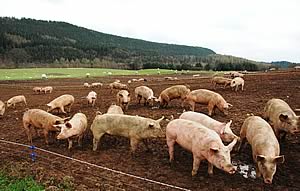 |
|||||||||
|
|||||||||||||||||||
|
|
NADIS
Pig Health Report for December 2007 15/01/08 Sows & Gilts Breeding herd productivity formed the basis of most of the reports through December and as is usually the case, management issues were at the root of many problems.
Difficulties are still reported in herds switching to batch farrowing as service procedures become condensed into a short time period. Overserving in general through the summer is also implicated in low-recorded farrowing rates. Uneven litter sizes may have resulted in some cases from seasonal infertility effects whilst gilt litter size and 2nd litter drops have also been reported. In the case of gilts poor health matching and lack of acclimatisation were suggested underlying factors. The usual reports of poor service timing and technique featured as did problems with late drop out returns. However, another feature noted in a number of cases was the lack of floor space provided for sows around and after service, in part a result of carrying higher numbers of sows. A number of health issues were also mentioned, and included:
A final observation from the reports is a number of veterinary surgeons visiting clients who are in the process of depopulating or reducing sow numbers, in some cases due to longstanding intractable disease, but with the harsh economic climate underlying these decisions. It remains to be seen how many will restock. Piglets Piglet quality at birth was highlighted as an issue affecting subsequent mortality (probably related to sow nutrition) although most mortality problems reported were either related to disease – especially rotavirus scour and joint ill - or management problems. The importance of timing of control measures was also highlighted with respect to coccidiosis treatment. The off-licence use of Baycox is very widespread but it is critical that piglets are dosed at the correct time – based upon veterinary advice – if the programme is to be fully effective. A serious problem with savaging was described in one herd with no apparent obvious trigger factor. Whilst not restricted to gilts only, this is one of the more difficult problems to deal with and often disappears before a definitive cause can be identified. Weaners Very low levels of reports of specific problems with weaners were received during December, although the general level of respiratory disease did rise at the end of the year. Of specific interest:
Overall prevalence of respiratory disease in growers jumped 40% in November and December compared to a low in October with the usual suspects of Enzootic pneumonia, APP, PRRS and late onset PMWS all implicated. In some smaller herds worms were also reported to be playing a part. Other herds, however, were reporting good responses to either vaccination or in feed medication. Colitis/Ileitis was a commonly reported and slightly surprisingly and worryingly there were a number of reports of Swine Dysentery – a disease whose impact on health generally and feed utilisation specifically can rarely be tolerated. Prolapsed rectums and rectal strictures also featured, as well as digestive and health difficulties arising from pigs changing over to wet feed too young. A comment received from more than one veterinary surgeon related to the continuing unwise practice of mixing sources of pigs into finishing sites. With such a wide range of infectious agents now implicated in the respiratory disease complex it is virtually impossible to health match weaners and disease problems are almost inevitable when mixing of sources occurs. Unusual lameness was reported in some newly arrived weaners but response to antibiotic treatment suggested an underlying infectious cause. Finally, it would be an unusual month when vice was not mentioned, although the only specific anecdotal report related to a small extensive herd in which tail docking was not practiced and tail biting was rife, highlighting the fact that tail biting can be seen in any system and can be triggered by a wide range of factors. As the coldest months of the year arrive problems might be anticipated with:
Mark White BVSc DPM MRCVS Copyright © NADIS 2008 www.nadis.org.uk
|
||||||||||||||||||

|
|
||||||||||||||||||
| home | agri-services | pedigree
pen | news | dairy | beef | machinery property | organisations | site map |
|||||||||||||||||||

